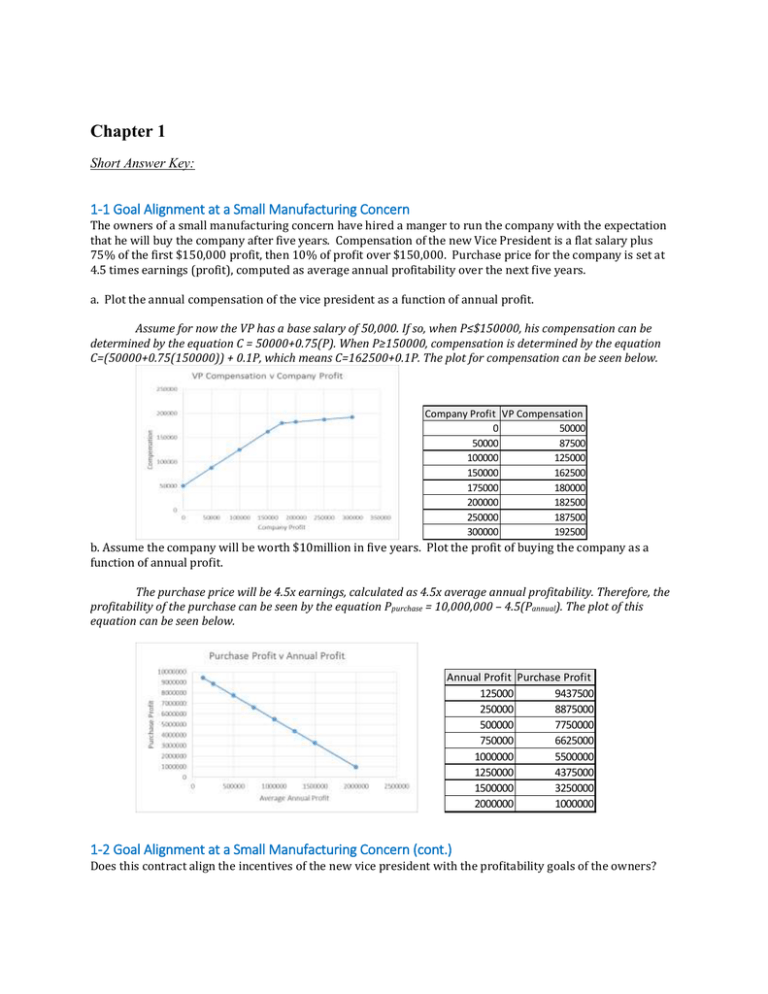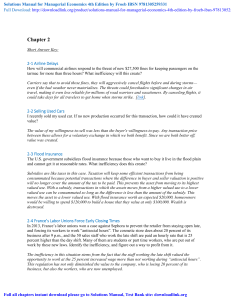Chapters 1-2 - Practice Problem Solutions
advertisement

Chapter 1 Short Answer Key: 1-1 Goal Alignment at a Small Manufacturing Concern The owners of a small manufacturing concern have hired a manger to run the company with the expectation that he will buy the company after five years. Compensation of the new Vice President is a flat salary plus 75% of the first $150,000 profit, then 10% of profit over $150,000. Purchase price for the company is set at 4.5 times earnings (profit), computed as average annual profitability over the next five years. a. Plot the annual compensation of the vice president as a function of annual profit. Assume for now the VP has a base salary of 50,000. If so, when P≤$150000, his compensation can be determined by the equation C = 50000+0.75(P). When P≥150000, compensation is determined by the equation C=(50000+0.75(150000)) + 0.1P, which means C=162500+0.1P. The plot for compensation can be seen below. Company Profit VP Compensation 0 50000 50000 87500 100000 125000 150000 162500 175000 180000 200000 182500 250000 187500 300000 192500 b. Assume the company will be worth $10million in five years. Plot the profit of buying the company as a function of annual profit. The purchase price will be 4.5x earnings, calculated as 4.5x average annual profitability. Therefore, the profitability of the purchase can be seen by the equation Ppurchase = 10,000,000 – 4.5(Pannual). The plot of this equation can be seen below. Annual Profit Purchase Profit 125000 9437500 250000 8875000 500000 7750000 750000 6625000 1000000 5500000 1250000 4375000 1500000 3250000 2000000 1000000 1-2 Goal Alignment at a Small Manufacturing Concern (cont.) Does this contract align the incentives of the new vice president with the profitability goals of the owners? No. Both the purchase price and the profit sharing create perverse incentives. The VP keeps $0.75 of each dollar earned up to $150,000, but only $0.10 of each dollar earned after $150K. Since earning more requires more effort (increasing marginal effort), he has little incentive to earn more than $150,000. And every dollar the VP earns raises the price that he will eventually pay for the company by $4.50, effectively penalizing him for increasing company profitability. 1-3 Goal Alignment at a Small Manufacturing Concern (cont.) Re-design the contract to better align the incentives of the new vice president with the profitability goals of the owners. One approach would be to establish a purchase price at the initiation of the contract. This would encourage the VP to make the company as profitable as possible, as it the increases to his marginal wealth of 10% above 150000 are not offset by the dramatic increases in purchase price. Also, this encourages him to make the company as profitable as possible as it will ultimately be his once the 5 years have passed. 1-4 Goal Alignment at New York City schools 1,800 New York City teachers who lost their jobs earlier this year have yet to apply for another job despite the fact that there are 1,200 openings. Why not? New York is the only city in the U.S. where teachers are guaranteed pay for life even if their school closes and they no longer have a permanent job. The policy costs DOE more than $100 million per year in salary and benefits. Those teachers go into the Absent Teacher Reserve pool, where they can be used as substitutes. The average salary for an ATR pool teacher? $82,000, with some making $100,000. Some teachers have been in the pool since 2006. 1-5 Goal Alignment between Airlines and Flight Crews Planes frequently push back from the gate on time, but then wait 2 feet away from the gate until it is time to queue up for take-off. This increases fuel consumption, and increases the time that passengers must sit in a cramped plane awaiting take-off. Why does this happen? Airlines are often evaluated and measured by their “on time” performance metrics. As this refers to boarding times rather than the time of actual departure, airlines would rather board the planes on time and wait on the tarmac than leaves passengers waiting at the gate. 1-6 Goal Alignment between Hospitals and the British Government In 2008, the Labour party in Britain promised that patients would have to wait for no more than four hours to be seen in an emergency room. How is the National Health Service meeting this performance goal? To meet this performance goal, seriously ill patients are being kept in ambulances. Thousands of people a year are having to wait outside the emergency departments because the trusts will not let them in until they will be able to be treated within four hours in accordance with the Labour pledge and government targets. In addition to keeping people outside, this also has reduced the ability of the ambulances to respond to emergency calls, leading to serious problems throughout the region. Chapter 2 Short Answer Key: 2-1 Airline Delays How will commercial airlines respond to the threat of new $27,500 fines for keeping passengers on the tarmac for more than three hours? What inefficiency will this create? Carriers say that to avoid those fines, they will aggressively cancel flights before and during storms— even if the bad weather never materializes. The threats could foreshadow significant changes in air travel, making it even less reliable for millions of road warriors and vacationers. By canceling flights, it could take days for all travelers to get home when storms strike. [link]. 2-2 Selling Used Cars I recently sold my used car. If no new production occurred for this transaction, how could it have created value? The value of my willingness-to-sell was less than the buyer's willingness-to-pay. Any transaction price between these allows for a voluntary exchange in which we both benefit. Since we are both better off, value was created. 2-3 Flood Insurance The U.S. government subsidizes flood insurance because those who want to buy it live in the flood plain and cannot get it at reasonable rates. What inefficiency does this create? Subsidies are like taxes in this case. Taxation will keep some efficient transactions from being consummated because potential transactions where the difference in buyer and seller valuation is positive will no longer cover the amount of the tax to be paid. This prevents the asset from moving to its highest valued use. With a subsidy, transactions in which the assets moves from a higher valued use to a lower valued use can be consummated so long as the difference is less than the amount of the subsidy. This moves the asset to a lower valued use. With flood insurance worth an expected $20,000, homeowners would be willing to spend $120,000 to build a house that they value at only $100,000. Wealth is destroyed. 2-4 France’s Labor Unions Force Early Closing Times In 2013, France’s labor unions won a case against Sephora to prevent the retailer from staying open late, and forcing its workers to work “antisocial hours”. The cosmetic store does about 20 percent of its business after 9 p.m., and the 50 sales staff who work the late shift are paid an hourly rate that is 25 percent higher than the day shift. Many of them are students or part time workers, who are put out of work by these new laws. Identify the inefficiency, and figure out a way to profit from it. The inefficiency in this situation stems from the fact that the staff working the late shift valued the opportunity to work at the 25 percent increased wage more than not working during “antisocial hours”. This regulation has not only diminished the value to the company, who is losing 20 percent of its business, but also the workers, who are now unemployed. 2-5 Kraft and Cadbury When Kraft recently bid $16.7 billion for Cadbury, Cadbury’s market value rose, but Kraft’s market value fell by more. What does this tell you about the value-creating potential of the deal? It means that Kraft's shareholders, and potential shareholders, think that Kraft’s profits will fall. This would be the case if Kraft's $16.7 billion bid is greater than the present value of the expected future profits from the Cadbury unit. Essentially, the combined market value of the firms separately is greater than the market value of the firms together. The market thinks that combining these assets will destroy value. 2-6 Price of Breast Reconstruction Versus Breast Augmentation Two similar surgeries, breast reconstruction and breast augmentation, have different prices. Breast augmentation is cosmetic surgery not covered by health insurance. Patients who want the surgery must pay for it themselves. Breast reconstruction following breast removal due to cancer is covered by insurance. The price for one of the surgeries has increased by about 10% each year since 1995, whereas the other has increased by only 2%per year. Which of the surgeries has the lower inflation rate? Why? Market pressure comes from two sources: consumers who can choose not to purchase, and competitors who can offer lower prices. Breast augmentation is subject to both of these forces, and thus has a lower price, while breast reconstruction is covered by insurance where the consumer pressure is weaker.



